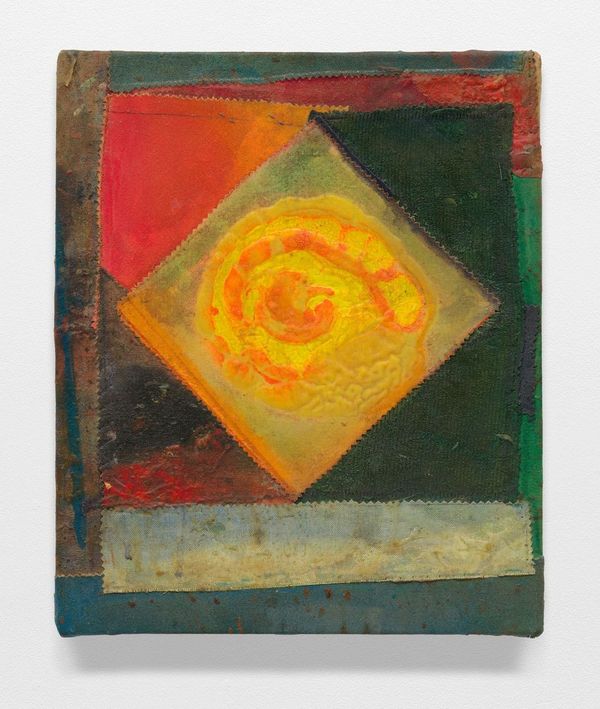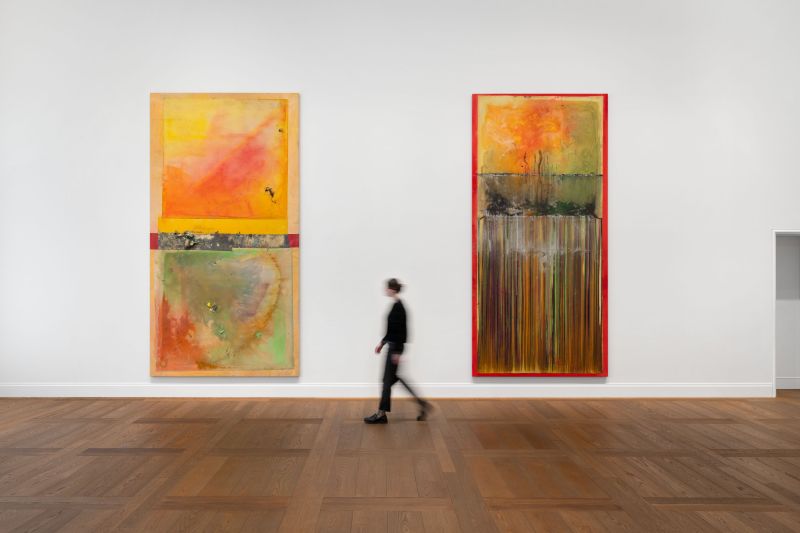Frank Bowling. Collage
The exhibition
“Drop the mic!” Bowling takes on the role of a DJ with his vast colorful canvases, through which improvised choreographies shine through, leaving the viewer amazed.
The gallery has supported the artist since 2016 and is now presenting his first solo show in Paris, drawn to the creative energy of the French capital. The works displayed on the ground floor, specially created for Hauser & Wirth, are bathed in light from large windows and capture the viewer’s attention with their grandeur and striking spontaneity. The exhibition then continues upstairs in a more subdued space, where the softer, diffused colors create an enchanting atmosphere. Visitors can only be hypnotized by the intensity emanating from these large formats, the result of performances influenced by Bowling’s inspirations. Drawing from the British tradition of landscape painting by Constable and Turner, he incorporates more contemporary inspirations, such as Rothko and Rauschenberg.
Ben Bowling offers a personal interpretation of his father’s art by presenting each piece on display. He invites the audience to derive their own interpretation, as his father would have wished. Ben also fondly recalls his grandmother, who used to sew upcycled clothing, a practice that, in a way, continues in this experimental work on canvas. Favoring the technique of collage, the artist creates brilliant, spontaneous, and vibrant compositions. His main inspiration for this solo show is "The Snail" by Matisse [1], discovered in the 1950s and rediscovered in 1992 in New York during a retrospective at the MoMA. This artwork became the starting point for a long plastic exploration since the 2000s, spanning painting, sculpture, and geometry.
Water, a fundamental element of his work, interferes by trickling, splashing, or even soaking the canvas, leaving it soaked. These interventions occur in rhythmic sequences, spontaneously executed by the artist. The water alters and makes each composition unique in its kind, subtly blending with the language between materials. Disruptive elements – a paintbrush, a coin, or even a small spoon – dropped onto the surface of the works create visible impacts, imperfections that form shockwaves, unsettling the viewer. At the heart of this discussion, painting plays the role of host. It is the element that brings all these materials together to form a single entity made of collages initiated by Bowling, but whose trajectory is guided by chance.
Marie Tuffou
[1] Henri Matisse, The Snail, 1953, cut and pasted wallpaper on canvas, 287x288 cm, Tate Modern, London.
The gallery has supported the artist since 2016 and is now presenting his first solo show in Paris, drawn to the creative energy of the French capital. The works displayed on the ground floor, specially created for Hauser & Wirth, are bathed in light from large windows and capture the viewer’s attention with their grandeur and striking spontaneity. The exhibition then continues upstairs in a more subdued space, where the softer, diffused colors create an enchanting atmosphere. Visitors can only be hypnotized by the intensity emanating from these large formats, the result of performances influenced by Bowling’s inspirations. Drawing from the British tradition of landscape painting by Constable and Turner, he incorporates more contemporary inspirations, such as Rothko and Rauschenberg.
Ben Bowling offers a personal interpretation of his father’s art by presenting each piece on display. He invites the audience to derive their own interpretation, as his father would have wished. Ben also fondly recalls his grandmother, who used to sew upcycled clothing, a practice that, in a way, continues in this experimental work on canvas. Favoring the technique of collage, the artist creates brilliant, spontaneous, and vibrant compositions. His main inspiration for this solo show is "The Snail" by Matisse [1], discovered in the 1950s and rediscovered in 1992 in New York during a retrospective at the MoMA. This artwork became the starting point for a long plastic exploration since the 2000s, spanning painting, sculpture, and geometry.
Water, a fundamental element of his work, interferes by trickling, splashing, or even soaking the canvas, leaving it soaked. These interventions occur in rhythmic sequences, spontaneously executed by the artist. The water alters and makes each composition unique in its kind, subtly blending with the language between materials. Disruptive elements – a paintbrush, a coin, or even a small spoon – dropped onto the surface of the works create visible impacts, imperfections that form shockwaves, unsettling the viewer. At the heart of this discussion, painting plays the role of host. It is the element that brings all these materials together to form a single entity made of collages initiated by Bowling, but whose trajectory is guided by chance.
Marie Tuffou
[1] Henri Matisse, The Snail, 1953, cut and pasted wallpaper on canvas, 287x288 cm, Tate Modern, London.
When
22/03/2025 - 24/05/2025

